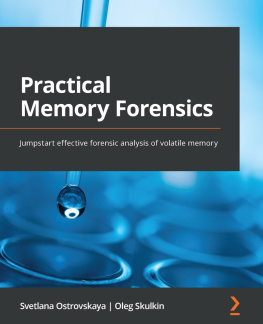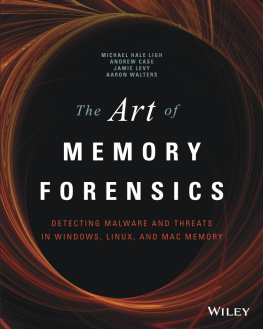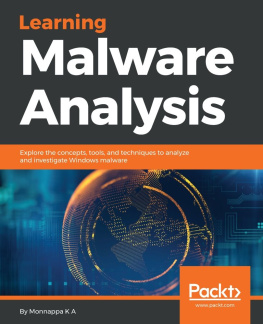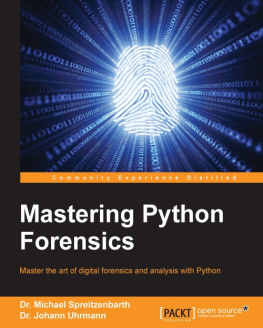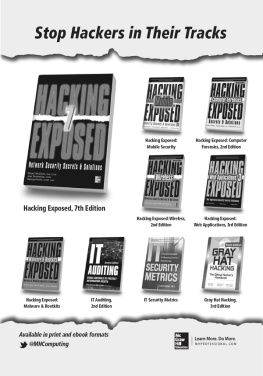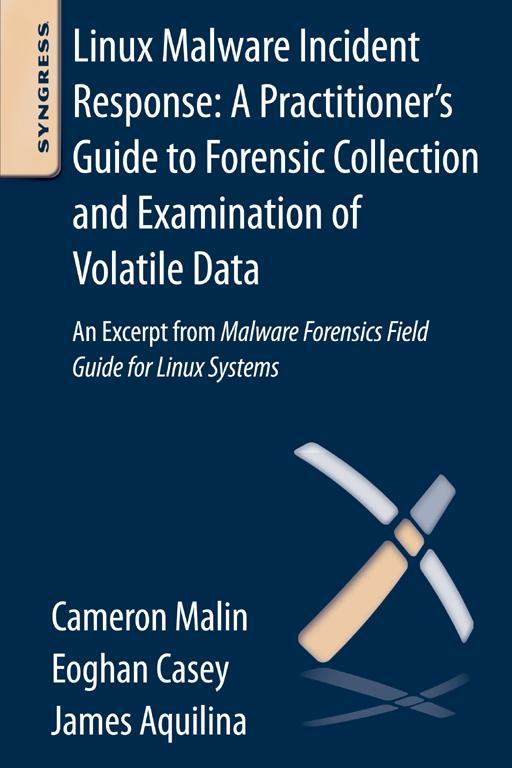Linux Malware Incident Response: A Practitioners Guide to Forensic Collection and Examination of Volatile Data
Cameron H. Malin
James M. Aquilina
Copyright
Syngress is an imprint of Elsevier
The Boulevard, Langford Lane, Kidlington, Oxford, OX5 1GB, UK
225 Wyman Street, Waltham, MA 02451, USA
First published 2013
Copyright 2013 Elsevier Inc. All rights reserved
No part of this publication may be reproduced or transmitted in any form or by any means, electronic or mechanical, including photocopying, recording, or any information storage and retrieval system, without permission in writing from the publisher. Details on how to seek permission, further information about the Publishers permissions policies and our arrangement with organizations such as the Copyright Clearance Center and the Copyright Licensing Agency, can be found at our website: www.elsevier.com/permissions
This book and the individual contributions contained in it are protected under copyright by the Publisher (other than as may be noted herein).
Notices
Knowledge and best practice in this field are constantly changing. As new research and experience broaden our understanding, changes in research methods, professional practices, or medical treatment may become necessary.
Practitioners and researchers must always rely on their own experience and knowledge in evaluating and using any information, methods, compounds, or experiments described herein. In using such information or methods they should be mindful of their own safety and the safety of others, including parties for whom they have a professional responsibility.
To the fullest extent of the law, neither the Publisher nor the authors, contributors, or editors, assume any liability for any injury and/or damage to persons or property as a matter of products liability, negligence or otherwise, or from any use or operation of any methods, products, instructions, or ideas contained in the material herein.
British Library Cataloguing-in-Publication Data
A catalogue record for this book is available from the British Library
Library of Congress Cataloging-in-Publication Data
A catalog record for this book is available from the Library of Congress
ISBN: 978-0-12-409507-6
For information on all Syngress publications visit our website at store.elsevier.com
This book has been manufactured using Print On Demand technology. Each copy is produced to order and is limited to black ink. The online version of this book will show color figures where appropriate.

Introduction
In the past, malicious code has been categorized neatly (e.g., viruses, worms, or Trojan Horses) based upon functionality and attack vector. Today, malware is often modular and multifaceted, more of a blended-threat with diverse functionality and means of propagation. Much of this malware has been developed to support increasingly organized, professional computer criminals. Indeed, criminals are making extensive use of malware to control computers and steal personal, confidential, or otherwise proprietary information for profit. hundreds of individuals were arrested for their involvement in digital theft using malware such as Zeus. A thriving gray market ensures that todays malware is professionally developed to avoid detection by current AntiVirus programs, thereby remaining valuable and available to any cyber-savvy criminal group.
Of growing concern is the development of malware to disrupt power plants and other critical infrastructure through computers, referred to by some as cyberwarfare. The StuxNet and Duqu malware that has emerged in the past few years powerfully demonstrates the potential for such attacks. This sophisticated malware enabled the attackers to alter the operation of industrial systems, like those in a nuclear reactor, by accessing programmable logic controllers connected to the target computers. Such attacks could shut down a power plant or other components of a societys critical infrastructure, potentially causing significant harm to people in a targeted region.
Foreign governments are funding teams of highly skilled hackers to develop customized malware to support industrial and military espionage. These types of well-organized attacks are designed to maintain long-term access to an organizations network, a form of Internet-enabled espionage known as the Advanced Persistent Threat (APT). The increasing use of malware to commit espionage, crimes, and launch cyber attacks is compelling more digital investigators to make use of malware analysis techniques and tools that were previously the domain of antivirus vendors and security researchers.
In addition, antisecurity groups such as AntiSec, Anonymous, and LulzSec are gaining unauthorized access to computer systems using a wide variety of techniques and malicious tools.
Whether to support mobile, cloud, or IT infrastructure needs, more and more mainstream companies are moving these days toward implementations of Linux and other open-source platforms within their environments. However, while malware developers often target Windows platforms due to market share and operating system prevalence, Linux systems are not immune to the malware scourge. Because Linux has maintained many of the same features and components over the years, some rootkits that have been in existence since 2004 are still being used today. For instance, the Adore rootkit, trojanized system binaries, and SSH servers are still being used on compromised Linux systems, including variants that are not detected by Linux security tools and antivirus software. Furthermore, there have been many new malware permutationsbackdoors, Trojan Horses, worms, rootkits, and blended-threatsthat have targeted Linux.
Over the last five years, computer intruders have demonstrated increased efforts and ingenuity in Linux malware attacks. Linux botnets have surfaced with infection vectors geared toward Web servers
Perhaps of greatest concern are the coordinated, targeted attacks against Linux systems. For several years, organized groups of attackers have been infiltrating Linux systems, apparently for the sole purpose of stealing information. Some of these attackers use advanced malware designed to undermine common security measures such as user authentication, firewalls, intrusion detection systems, and network vulnerability scanners. For instance, rather than opening their own listening port, which could trigger security alerts, many of these Linux rootkits inject/hijack existing running services. In addition, these rootkits check incoming connections for special backdoor characteristics to determine whether a remote connection actually belongs to the intruder and make it more difficult to detect the presence of a backdoor using network vulnerability scanners. These malicious applications also have the capability to communicate with command and control (C2) servers and exfiltrate data from compromise Linux systems, including devices running Android.


